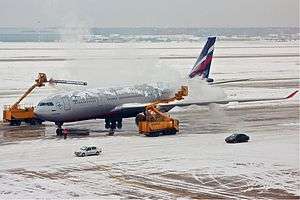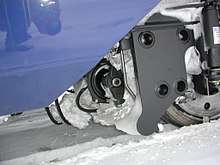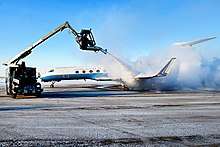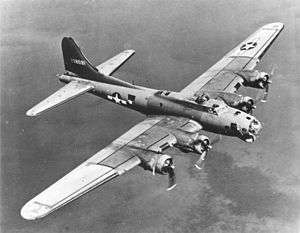De-icing
De-icing is the process of removing snow, ice or frost from a surface. Anti-icing is understood to be the application of chemicals that not only de-ice but also remain on a surface and continue to delay the reformation of ice for a certain period of time, or prevent adhesion of ice to make mechanical removal easier.


Approaches
De-icing can be accomplished by mechanical methods (scraping, pushing); through the application of heat; by use of dry or liquid chemicals designed to lower the freezing point of water (various salts or brines, alcohols, glycols); or by a combination of these different techniques.
Trains and rail switches

Trains and rail switches in arctic regions have large problems with snow and ice build up. They need a constant heat source in cold days to assure functionality. On trains it is primarily the brakes, suspension and couplers that require heaters for de-icing. On rails it is primarily the switches that are sensitive to ice. These high-powered electrical heaters efficiently prevent ice formation and rapidly melt any ice that forms.
The heaters are preferably made of PTC material, e.g. PTC rubber, to avoid overheating and potentially destroying the heaters. These heaters are self-limiting and require no regulating electronics; they cannot overheat and require no overheat protection.[1]
Aircraft

.png)
On the ground, when there are freezing conditions and precipitation, de-icing an aircraft is commonly practiced. Frozen contaminants interfere with the aerodynamic properties of the vehicle. Furthermore, dislodged ice can damage the engines.
De-icing fluids typically consist of a glycol-water solution containing a dye and agents to protect the metal surface. A range of glycols are employed. Thickeners are also used to help the deicing agent adhere to the airplane body.[2]:43 Ethylene glycol (EG) fluids are still in use for aircraft de-icing in some parts of the world because it has a lower operational use temperature (LOUT) than propylene glycol (PG). However, PG is common because it is less toxic than ethylene glycol.[3]:2–29[4]
When applied, most of the de-icing fluid does not adhere to the aircraft surfaces, and falls to the ground.[2]:101 Airports typically use containment systems to capture the used liquid, so that it cannot seep into the ground and water courses. Even though PG is classified as non-toxic, it pollutes waterways since it consumes large amounts of oxygen as it decomposes, causing aquatic life to suffocate. (See Environmental impacts and mitigation.)
Infrared heating de-icing
Direct infrared heating has also been developed as an aircraft de-icing technique. This heat transfer mechanism is substantially faster than conventional heat transfer modes used by conventional de-icing (convection and conduction) due to the cooling effect of the air on the de-icing fluid spray.
One infrared de-icing system requires that the heating process take place inside a specially-constructed hangar. This system has had limited interest among airport operators, due to the space and related logistical requirements for the hangar. In the United States, this type of infrared de-icing system has been used, on a limited basis, at two large hub airports and one small commercial airport.[2]:80–81 [5]
Another infrared system uses mobile, truck-mounted heating units that do not require the use of hangars.[6] The manufacturer claims that the system can be used for both fixed wing aircraft and helicopters, although it has not cited any instances of its use on commercial aircraft.[7]
Airport pavement
De-icing operations for airport pavement (runways, taxiways, aprons, taxiway bridges) may involve several types of liquid and solid chemical products, including propylene glycol, ethylene glycol and other organic compounds. Chloride-based compounds (e.g. salt) are not used at airports, due to their corrosive effect on aircraft and other equipment.[2]:34–35
Urea mixtures have also been used for pavement de-icing, due to their low cost. However, urea is a significant pollutant in waterways and wildlife, as it degrades to ammonia after application, and it has been largely been phased out at U.S. airports. In 2012 the U.S. Environmental Protection Agency (EPA) prohibited use of urea-based deicers at most commercial airports.[8]
Roadways
In 2013, an estimated 14M tons of salt were used for deicing roads in North America.[9]
De-icing of roads has traditionally been done with salt, spread by snowplows or dump trucks designed to spread it, often mixed with sand and gravel, on slick roads. Sodium chloride (rock salt) is normally used, as it is inexpensive and readily available in large quantities. However, since salt water still freezes at −18 °C (0 °F), it is of no help when the temperature falls below this point. It also has a strong tendency to cause corrosion, rusting the steel used in most vehicles and the rebar in concrete bridges. Depending on the concentration, it can be toxic to some plants and animals, and some urban areas have moved away from it as a result. More recent snowmelters use other salts, such as calcium chloride and magnesium chloride, which not only depress the freezing point of water to a much lower temperature, but also produce an exothermic reaction. They are somewhat safer for sidewalks, but excess should still be removed.
More recently, organic compounds have been developed that reduce the environmental issues connected with salts and have longer residual effects when spread on roadways, usually in conjunction with salt brines or solids. These compounds are often generated as byproducts of agricultural operations such as sugar beet refining or the distillation process that produces ethanol.[10][11] Other organic compounds are wood ash and a deicing salt called calcium magnesium acetate made from roadside grass or even kitchen waste.[12] Additionally, mixing common rock salt with some of the organic compounds and magnesium chloride results in spreadable materials that are both effective to much colder temperatures (−34 °C or −29 °F) as well as at lower overall rates of spreading per unit area.[13]
Solar road systems have been used to maintain the surface of roads above the freezing point of water. An array of pipes embedded in the road surface is used to collect solar energy in summer, transfer the heat to thermal banks and return the heat to the road in winter to maintain the surface above 0 °C (32 °F).[14] This automated form of renewable energy collection, storage and delivery avoids the environmental issues of using chemical contaminants.
It was suggested in 2012 that superhydrophobic surfaces capable of repelling water can also be used to prevent ice accumulation leading to icephobicity. However, not every superhydrophobic surface is icephobic[15] and the method is still under development.[16]
Chemical de-icers
All chemical de-icers share a common working mechanism: they chemically prevent water molecules from binding above a certain temperature that depends on the concentration. This temperature is below 0 °C, the freezing point of pure water. Sometimes, there is an exothermic dissolution reaction that allows for an even stronger melting power. The following lists contains the most-commonly used de-icing chemicals and their typical chemical formula.
- Sodium chloride (NaCl or table salt; the most common de-icing chemical)
- Magnesium chloride (MgCl
2, often added to salt to lower its working temperature) - Calcium chloride (CaCl
2, often added to salt to lower its working temperature) - Potassium chloride (KCl)
- Calcium magnesium acetate (CaMg
2(CH
3COO)
6) - Potassium acetate (CH
3COOK) - Potassium formate (CHO
2K) - Sodium formate (HCOONa)
- Calcium formate (Ca(HCOO)
2) - Urea (CO(NH
2)
2), a common fertilizer - Agricultural By-Products (generally used as additives to sodium chloride)
(these are antifreeze agents and scarcely used on roads)
- Methanol (CH
4O) - Ethylene glycol (C
2H
6O
2) - Propylene glycol (C
3H
8O
2) - Glycerol (C
3H
8O
3)
Fluid types
There are several types of aircraft de-icing fluid, falling into two basic categories:
- De-icing fluids: Heated glycol diluted with water for de-icing and snow/frost removal, also referred to as Newtonian fluids (owing to their viscous flow similar to water)
- Anti-icing fluids: unheated, undiluted propylene glycol based fluids that has been thickened (imagine half-set gelatin), also referred to as non-Newtonian fluids (owing to their characteristic viscous flow), applied to retard the future development of ice or to prevent falling snow or sleet from accumulating. Anti-icing fluids provide holdover protection against the formation of ice while the aircraft is stationary on the ground. However, when subjected to shearing force such as the air flow over the fluid surface, when an aircraft is accelerating for takeoff, the fluid's entire rheology changes and it becomes significantly thinner, running off to leave a clean and smooth aerodynamic surface to the wing.
In some cases both types of fluid are applied to aircraft, first the heated glycol/water mixture to remove contaminants, followed by the unheated thickened fluid to keep ice from reforming before the aircraft takes off. This is called "a two-step procedure".
Methanol de-ice fluid has been employed for years to de-ice small wing and tail surfaces of small to medium-sized general aviation aircraft and is usually applied with a small hand-held sprayer. Methanol can only remove frost and light ground ice prior to flight.
Mono-ethylene, di-ethylene and propylene glycol are non-flammable petroleum products and similar products are most commonly found in automotive cooling systems. Glycol has very good de-icing properties and the aviation grade is referred to as SAE/ISO/AEA Type I (AMS 1424 or ISO 11075). it is usually applied to contaminated surfaces diluted with water at 95 degrees Fahrenheit (35 °C) using a cherry picker on a truck containing 1,500 to 2,000 US gal (5,680 to 7,570 L; 1,250 to 1,670 imp gal) for on-ramp or departure runway entry point application. Colour-dyed fluid is preferred as it can be confirmed easily by visual observation that an aircraft has received a de-ice application. Runoff of Type I fluid appears to turn slush a pink tinge, hence the term "pink snow." Otherwise, all Type I fluids are orange.
In 1992, the Dead Sea Works began marketing a de-icer based on salts and minerals from the Dead Sea.[17]
In-flight aircraft de-icing
Pneumatic systems

In-flight ice buildups are most frequent on the leading edges of the wings, tail and engines (including the propellers or fan blades). Lower speed aircraft frequently use pneumatic de-icing boots on the leading edges of wings and tail for in-flight de-icing. The rubber coverings are periodically inflated, causing ice to crack and flake off. Once the system is activated by the pilot, the inflation/deflation cycle is automatically controlled. In the past, it was thought such systems can be defeated if they are inflated prematurely; if the pilot did not allow a fairly thick layer of ice to form before inflating the boots, the boots would merely create a gap between the leading edge and the formed ice. Recent research shows “bridging” does not occur with modern boots.[18]
Electric systems
Some aircraft may also use electrically heated resistive elements embedded in a rubber sheet cemented to the leading edges of wings and tail surfaces, propeller leading edges, and helicopter rotor blade leading edges. This de-icing system was developed by United States Rubber Company in 1943.[19] Such systems usually operate continuously. When ice is detected, they first function as de-icing systems, then as anti-icing systems for continued flight in icing conditions. Some aircraft use chemical de-icing systems which pump antifreeze such as alcohol or propylene glycol through small holes in the wing surfaces and at the roots of propeller blades, melting the ice, and making the surface inhospitable to ice formation. A fourth system, developed by NASA, detects ice on the surface by sensing a change in resonance frequency. Once an electronic control module has determined that ice has formed, a large current spike is pumped into the transducers to generate a sharp mechanical shock, cracking the ice layer and causing it to be peeled off by the slipstream.
Air bleed systems
Many modern civil fixed-wing transport aircraft use anti-ice systems on the leading edge of wings, engine inlets and air data probes using warm air. This is bled from engines and is ducted into a cavity beneath the surface to be anti-iced. The warm air heats the surface up to a few degrees above 0 °C (32 °F), preventing ice from forming. The system may operate autonomously, switching on and off as the aircraft enters and leaves icing conditions.
Environmental impacts and mitigation
De-icing salts such as sodium chloride or calcium chloride leach into natural waters, strongly affecting their salinity.[9]
Ethylene glycol and propylene glycol are known to exert high levels of biochemical oxygen demand (BOD) during degradation in surface waters. This process can adversely affect aquatic life by consuming oxygen needed by aquatic organisms for survival. Large quantities of dissolved oxygen (DO) in the water column are consumed when microbial populations decompose propylene glycol.[3]:2–23
Sufficient dissolved oxygen levels in surface waters are critical for the survival of fish, macroinvertebrates, and other aquatic organisms. If oxygen concentrations drop below a minimum level, organisms emigrate, if able and possible, to areas with higher oxygen levels or eventually die. This effect can drastically reduce the amount of usable aquatic habitat. Reductions in DO levels can reduce or eliminate bottom feeder populations, create conditions that favor a change in a community's species profile, or alter critical food-web interactions.[3]:2–30
In one case, a significant snow in Atlanta in early January 2002 caused an overflow of such a system, briefly contaminating the Flint River downstream of the Atlanta airport.
Some airports recycle used de-icing fluid, separating water and solid contaminants, enabling reuse of the fluid in other applications. Other airports have an on-site wastewater treatment facility, and/or send collected fluid to a municipal sewage treatment plant or a commercial wastewater treatment facility.[2]:68–80 [20]
The toxicity of de-icing fluids is another environmental concern, and research is underway to find less toxic (i.e. non-glycol-based) alternatives.[21][22]
See also
| Wikimedia Commons has media related to De-icing of aircraft. |
References
- 2012 Autumn & Winter Season (Drivers' Briefing). London, UK: First Capital Connect. September 2012.
- Technical Development Document for the Final Effluent Limitations Guidelines and New Source Performance Standards for the Airport Deicing Category (Report). Washington, D.C.: U.S. Environmental Protection Agency (EPA). April 2012. EPA-821-R-12-005.
- Environmental Impact and Benefit Assessment for the Final Effluent Limitation Guidelines and Standards for the Airport Deicing Category (Report). EPA. April 2012. EPA-821-R-12-003.
- Stefl., Barbara A.; George, Kathleen F. (2014), "Antifreezes and Deicing Fluids", Kirk-Othmer Encyclopedia of Chemical Technology, New York: John Wiley, doi:10.1002/0471238961.0114200919200506.a01.pub2, ISBN 9780471238966
- Rosenlof, Kim (2013-10-02). "Infrared De-icing Speeds Process and Reduces Cost". Aviation International News Online. Midland Park, NJ.
- APS Aviation, Inc. (December 1998). Deicing with a Mobile Infrared System (Report). Montreal, Quebec. Report prepared for Transport Canada.
- "Ice Cat Aircraft Deicing System". Bonner Springs, KS: Trimac Industries. 2004. Archived from the original on 2016-06-20. Retrieved 2016-05-29.
- "Airport Deicing Effluent Guidelines". EPA. 2016-04-21.
- Miguel Cañedo-Argüelles, Ben J. Kefford, Christophe Piscart, Narcís Prata, Ralf B.Schäferd, Claus-Jürgen Schulze (2013). "Salinisation of Rivers: An Urgent Ecological Issue". Environmental Pollution. 173: 157–167. doi:10.1016/j.envpol.2012.10.011.CS1 maint: multiple names: authors list (link)
- Amanda Rabinowitz (February 25, 2008). "Beets Part of New Recipe to Treat Icy Roads". National Public Radio.
- Richard J. Brennan (January 21, 2012). "Beet juice melts ice from winter roads". Toronto Star.
- The alternatives to salt for battling ice: cheese, beets and ash
- "About Magic Salt". 2007. Archived from the original on 2009-06-05.
- "Thermal Energy Storage in ThermalBanks for under runway heating". ICAX Ltd, London. Retrieved 2011-11-24.
- Nosonovsky, M.; Hejazi, V. (2012). "Why superhydrophobic surfaces are not always icephobic". ACS Nano. 6 (10): 8488–8913. doi:10.1021/nn302138r. PMID 23009385.
- Hejazi, V.; Sobolev, K.; Nosonovsky, M. I. (2013). "From superhydrophobicity to icephobicity: forces and interaction analysis". Scientific Reports. 3: 2194. Bibcode:2013NatSR...3E2194H. doi:10.1038/srep02194. PMC 3709168. PMID 23846773.
- Dead Sea product melts snow. (Dead Sea Works markets snow melting compound)
- aopa.org pdf file Archived February 2, 2007, at the Wayback Machine
- "De-Icer for Airplane Propeller is Made of Electric Rubber" Popular Mechanics, December 1943
- Tom Gibson (September 2002). "Let the Bugs Do the Work". Progressive Engineer. Archived from the original on 8 February 2011. Retrieved 21 February 2011.
- U.S. Federal Aviation Administration. Airport Cooperative Research Program (April 2010). "Alternative Aircraft and Pavement Deicers and Anti-icing Formulations with Improved Environmental Characteristics." Research Results Digest 9.
- SAE International (2011). "Issues and Testing of Non-Glycol Aircraft Ground Deicing Fluids." Archived 2013-02-02 at the Wayback Machine doi:10.4271/2011-38-0058